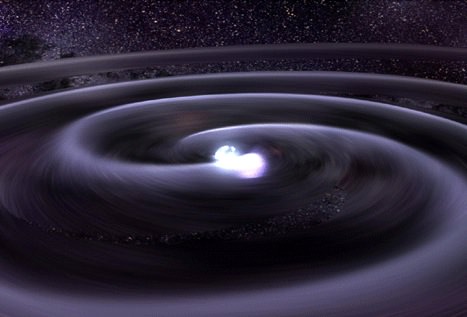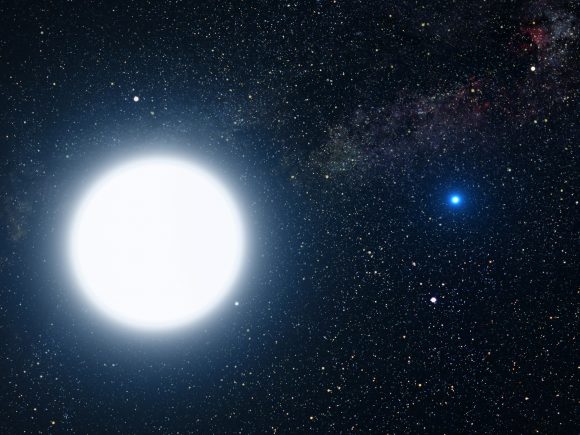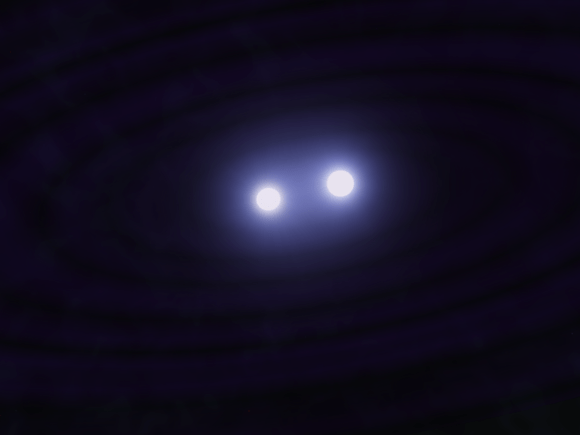In 2013, the European Space Agency (ESA) deployed the Gaia mission, a space observatory designed to measure the positions of movements of celestial bodies. For the past four years, Gaia has been studying distant stars, planets, comets, asteroids, quasars and other astronomical objects, and the data it has acquired will be used to construct the largest and most precise 3D space catalog ever made, totaling 1 billion objects.
The second release of Gaia data, which took place on April 25th, 2018, has already resulted in a number of impressive discoveries. The latest was made by an international team of scientists who identified 13,928 white dwarfs within 100 parsecs (326 light-years) of the Sun, many of which were formed through mergers. This is the first time that white dwarf stars have been directly detected within the Solar neighborhood.
The study which describes their findings, “Gaia Reveals Evidence for Merged White Dwarfs“, recently appeared online and is being considered for publication in the Monthly Notices of the Royal Astronomical Society. The study was led by Dr. Mukremin Kilic, an associate professor at the University of Oklahoma, and included members from the Institute for Astronomy at the University of Edinburgh and the University of Montreal.

Basically, white dwarfs are what become of the majority of stars (with masses less than 8 Solar masses) once they exit the main sequence phase of their lives. This consists of a star exhausting its hydrogen fuel and expanding to several times its size (entering its Red Giant Branch Phase). These stars then blow off their external layers (a supernova) and leaving behind a white dwarf remnant.
By studying them, astronomers can learn far more about the life cycle of stars and how they evolve. As Dr. Kilic explained to Universe Today via email:
“[W]e’re basically doing Galactic archaeology when we study nearby white dwarfs. They tell us about the ages and star formation histories of the Galactic disk and halo. More importantly, white dwarfs explode as a Type Ia supernova when they reach 1.4 times the mass of the Sun. We use these supernovae to study the shape of the Universe and conclude that the expansion of the universe is accelerating. However, we have not yet found the progenitor systems of these supernovae. One of the channels to form Type Ia supernovae is through mergers of white dwarfs. Hence, the direct detection of merged white dwarfs is important for understanding the frequency of these white dwarf mergers.”
However, until recently only a few hundred white stars have been found within the local galactic neighborhood (500 within a 40 parsec radius). In addition, astronomers were only able to obtain accurate parallax (distance) measurements for about half of these. But thanks to the Gaia data, the number of white dwarfs systems that astronomers are able to study has increased exponentially.

“Gaia provided distance measurements,” said Kilic. “We can now create complete samples of white dwarfs within a given volume. For example, prior to Gaia, we only knew about 100 white dwarfs within 20 parsecs of the Sun. With Gaia Data Release 2, we identified more than 13,000 white dwarfs within 100 parsecs of the Sun. The difference in numbers is amazing!”
The Gaia data was also helpful in determining the nature of these white dwarf systems and how they formed. As they indicate in their study, previous research has shown that the majority of white dwarf stars in our local galaxy (roughly 56%) are the product of single-star evolution, whereas 7 to 23% were the product of mergers between binaries. The remainder were white dwarf binaries, or binaries with one white dwarf and a main sequence star.
Using the Gaia data – which included the color and distribution data of thousands of white dwarf stars within ~326 light-years of the Sun – the team was able to determine how massive these stars are. This, in turn, provided vital clues as to how they formed, which indicated that mergers were far more common than previous studies suggested. As Kilic explained:
“Massive white dwarfs tend to be smaller, which means that they are also fainter (since they have a smaller surface area). Since Gaia gave us a complete sample of white dwarfs within 100 parsecs of the Sun, for the first time, we were able to derive the magnitude distribution (hence the mass distribution) of thousands of white dwarfs and find a large fraction of massive white dwarfs. We see that the number of massive white dwarfs is significantly higher than expected from single star evolution. Therefore, we concluded that many of these massive white dwarfs actually formed through mergers in previously binary systems.”

From this, the team was able to assemble the first reliable Hertzsprung-Russell Diagram for nearby field white dwarf stars, as well as estimates on how often white dwarf binaries merge. As Kilic indicated, this could have significant implications for other areas of astronomical study.
“Based on the frequency of these single white dwarfs that formed through mergers, we can estimate how many white dwarf mergers occur on average and with what mass distribution,” he said. “We can then infer the rate of Type Ia supernovae from these mergers and see if it’s enough to explain part or all of the Ia supernova explosions. This is an ongoing area of research and I’m sure we will some results on these very soon.”
These findings are yet another gem to come from the second Gaia data release, which has proven to be a treasure trove for astronomers. The third release of Gaia data is scheduled to take place in late 2020, with the final catalog being published in the 2020s. Meanwhile, an extension has already been approved for the Gaia mission, which will now remain in operation until the end of 2020 (to be confirmed at the end of this year).
Further Reading: arXiv


I can’t see comments from others? Boooo
“For example, prior to Gaia, we only knew about 100 white dwarfs within 20 parsecs of the Sun. With Gaia Data Release 2, we identified more than 13,000 white dwarfs within 100 parsecs of the Sun. The difference in numbers is amazing!””
Since the volume increases by a factor of 125 from a 20 parsec sphere to 100 parsec sphere, the difference is not amazing at all (100*125 = 12,500)
Stars of less than 8 solar masses enter the red giant branch phase and shed their outer layers in a supernova? Really? Sirius is a supergiant (artists impression caption)? Please clarify. I get the type 1a supernova when a white dwarf absorbs matter from a neighbour but planetary nebulae are not supernova remnants. Am I missing something?
Somebody got their signs mixed up, stars greater than 8 MSun tend to type II supernovae